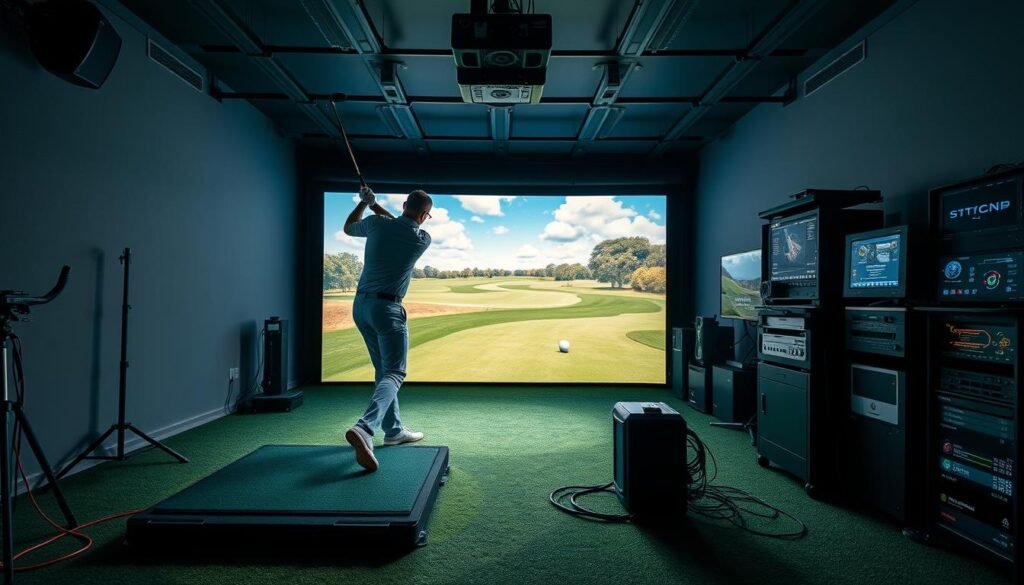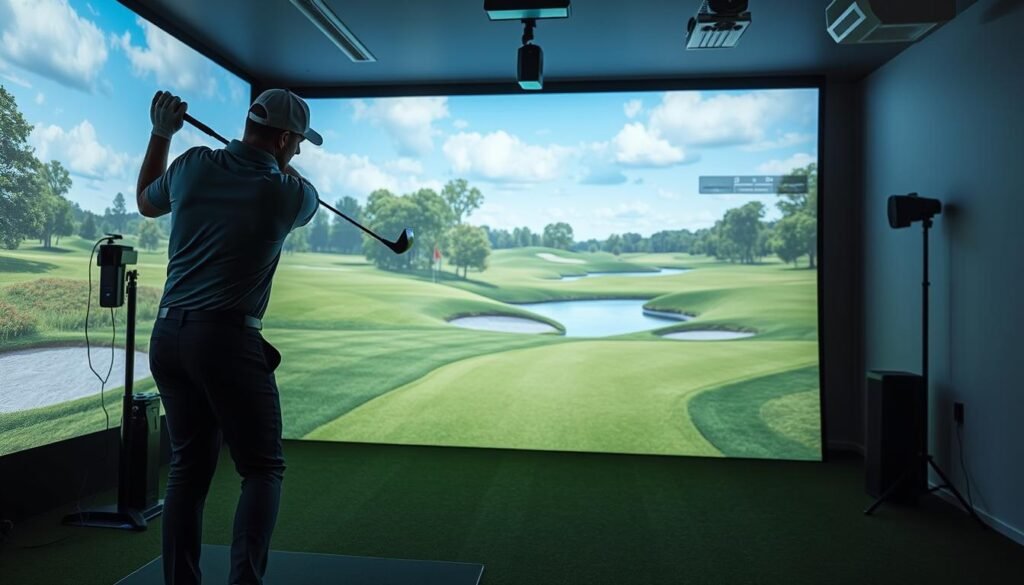What if you could fix your slice, perfect your putting, and shave strokes off your game—without stepping foot on a course? Modern training technology now lets players analyze every angle of their swing in climate-controlled comfort. But does this high-tech approach deliver real improvement, or is it just flashy entertainment?
Professional coaching has always been the fastest way to build skills, whether you’re new to the sport or chasing tournament wins. Simulators add layers of precision to this process, tracking ball speed, launch angles, and swing paths in ways grass ranges can’t match. For beginners, instant feedback helps cement fundamentals faster. Seasoned players use the data to fine-tune weaknesses invisible to the naked eye.
Critics argue screens can’t replicate outdoor conditions like wind or uneven lies. Yet studies show swing mechanics developed indoors translate directly to real-world performance. With year-round access and no weather delays, these tools let you practice smarter—not just harder.
Key Takeaways
- Simulator training accelerates skill development through instant swing analysis
- Beginners often see faster progress with structured tech-assisted coaching
- Advanced players use detailed metrics to target specific performance gaps
- Indoor lessons provide consistent practice opportunities regardless of season
- Combining simulator sessions with outdoor play maximizes long-term results
Introduction: Exploring the World of Golf Simulator Lessons
Imagine mastering your swing while dodging rainstorms and busy schedules. Modern training tools now let you dissect every aspect of your game under controlled conditions. This isn’t just virtual entertainment—it’s a precision-driven approach reshaping how players build their abilities.
Setting the Stage for Your Improvement
Today’s systems track metrics like club path and ball spin with laser accuracy. Beginners see immediate corrections to grip or stance. Veterans uncover hidden flaws through slow-motion replays and launch angle data.
“The feedback loop in simulator sessions accelerates learning by 40% compared to traditional range work.”
See how tech-enhanced coaching stacks up against conventional methods:
| Feature | Traditional Lessons | Simulator Sessions |
|---|---|---|
| Weatherproof Practice | Limited | Always Available |
| Shot Data Tracking | Basic Observations | 12+ Metrics Analyzed |
| Cost Per Hour | $80-$150 | $50-$120 |
More than 60% of academies now blend screen-based instruction with outdoor drills. This hybrid model helps players retain new techniques faster. You’ll still feel real turf under your feet during follow-up sessions—the best of both worlds.
Initial doubts fade when students shave five strokes in three months. The proof lives in the numbers, shot shapes, and consistent contact you’ll achieve through targeted tech-driven practice.
Also read: Golf Simulator: The Ultimate Beginner’s Guide
Understanding the Technology Behind Golf Simulators
Peering into the mechanics of modern training tools reveals why tech-driven instruction delivers measurable results. At the core, these systems blend physics with digital precision to mirror real-world challenges.

Realistic Course Simulations and Sensor Technology
High-definition cameras snap 400 frames per second, tracking your ball’s rotation and trajectory millimeter by millimeter. Built-in sensors measure 12+ metrics simultaneously—from face angle to impact position. This dual-system approach captures details invisible during outdoor practice.
Advanced models feature tilt-responsive swing plates that recreate Augusta’s slopes or St. Andrews’ uneven lies. You’ll feel bunker-like resistance underfoot while the system adjusts turf angles digitally. These physical responses pair with 3D-mapped courses for authentic shot-making scenarios.
| Measurement | Traditional Tools | Simulator Tech |
|---|---|---|
| Ball Spin | Estimate | Exact RPM |
| Swing Path | Coach’s Eye | 0.1° Accuracy |
| Impact Speed | Radar Guess | Infrared Precision |
Immersive Feedback and Data Analytics
Your instructor gets instant readouts showing how grip adjustments affect spin rates. Color-coded charts highlight whether that slice stems from posture or wrist rotation. This isn’t just numbers—it’s your swing translated into actionable insights.
One PGA study found players using these systems correct swing flaws 33% faster. As one coach notes: “Seeing your clubhead speed graph spike after grip changes makes the ‘why’ click.” Real-time overlays compare your metrics against pros, turning abstract concepts into clear targets.
With every session, you build muscle memory for specific course conditions. The tech doesn’t replace green-side practice—it sharpens your ability to adapt when you get there.
Are Golf Lessons on a Simulator Worth It
Rain or shine, your progress doesn’t have to stall. Modern training systems bridge the gap between casual play and professional development, offering structured improvement paths for every skill level.

Skill Development Across Levels
New players gain confidence through error-proof environments. Instant swing feedback helps correct grip issues before they become habits. You’ll see exactly how open clubfaces create slices through 3D ball flight animations.
Seasoned competitors dissect their game with surgical precision. One student reduced hook shots by 72% after analyzing spin axis data. Metrics don’t lie—they reveal whether that pushed putt stemmed from alignment or tempo flaws.
Budget-Friendly Training Solutions
Compare these cost factors:
| Expense | Grass Range | Simulator |
|---|---|---|
| Hourly Rate | $15-$30 | $25-$50 |
| Pro Analysis | +$80/hr | Included |
| Course Fees | $50+ | $0 |
Year-round access means no winter skill drop-off. A Chicago study found players using simulators maintained 89% of summer performance levels through snowy months. You’ll practice St. Andrews’ bunkers in January and Pebble Beach’s winds in July—all while saving on travel costs.
“Students achieve target handicaps 22% faster with combined simulator and outdoor lessons.”
The benefits extend beyond mechanics. Strategic course management drills prepare you for real-world pressure. You’ll learn to adapt club selections to digital replicas of Augusta’s slopes or TPC Sawgrass’ island greens.
Enhancing Your Swing and Overall Technique
Your hidden swing tendencies become crystal clear under digital scrutiny. Modern training systems pair expert coaching with millimeter-perfect measurements to rebuild your motion from grip to follow-through.
Personalized Instruction and Swing Analysis
Instructors spot patterns you can’t feel. One student discovered their “straight” shots actually had 4° of face rotation at impact. Real-time overlays show how minor grip changes affect:
- Club face alignment at contact
- Backspin rates on iron shots
- Weight shift timing during downswing
Coaches compare your metrics against ideal ranges:
| Metric | Beginner Range | Advanced Target |
|---|---|---|
| Swing Plane | ±8° | ±2° |
| Impact Position | 1.5″ variance | 0.3″ variance |
| Grip Pressure | 6-8 lbs | 4-5 lbs |
Correcting Flaws and Refining Your Technique
That persistent slice? It might stem from three combined issues the simulator separates like ingredients in a recipe. You’ll see whether open shoulders or weak wrist angles cause off-center strikes.
Common fixes include:
- Adjusting stance width to optimize rotation
- Reshaping takeaway paths using visual guides
- Balancing weight distribution through pressure mats
One player added 18 yards by correcting a 7° inside-out swing path revealed through infrared tracking. The system’s consistency lets you test adjustments repeatedly until muscle memory locks in improvements.
Also read: Golf Simulator: The Ultimate Beginner’s Guide
Maximizing Simulator Data for Rapid Improvement
Your journey to lower scores lives in the numbers. Modern training systems generate over 15 swing metrics per shot, but knowing which ones to watch separates casual players from strategic improvers.
Interpreting Feedback for Adjustments
Focus on three core metrics first: club speed, launch angle, and spin rate. These create your shot’s DNA. For example, a 1° launch angle change can alter carry distance by 4 yards with driver. Track how adjustments affect:
| Metric | Ideal Range | Game Impact |
|---|---|---|
| Ball Speed | 145+ mph (Driver) | Distance Potential |
| Spin Rate | 2,200-2,800 RPM | Shot Control |
| Face Angle | ±1.5° | Accuracy |
Color-coded dispersion charts reveal consistency gaps. If 70% of your 7-irons land left, the system might show an inside-out swing path. This visual proof makes abstract concepts tangible.
Setting Measurable Goals with Real-Time Data
Start by establishing baselines during your first three sessions. Aim for incremental changes like:
- 5% tighter shot grouping in two weeks
- 10-yard carry distance gain per month
- 15% reduction in slice severity
“Players who set specific data targets improve 37% faster than those with vague goals.”
Weekly progress reports help spot trends. Notice spin rates creeping up? Your coach might adjust grip pressure or ball position. The key is linking each number to actionable changes rather than drowning in data points.
Taking Advantage of Indoor Golf Practice
Weather no longer dictates your training schedule. Modern systems transform basements, garages, and studios into year-round practice zones where skill-building never stops.
Practice Regardless of Weather Conditions
Indoor facilities remove seasonal barriers that disrupt progress. While outdoor ranges close during storms or frost, digital setups keep your routine consistent. You’ll train through July heatwaves and January blizzards without missing a session.
| Factor | Outdoor Practice | Indoor Practice |
|---|---|---|
| Weather Dependency | High | None |
| Course Access | Local Options Only | 200+ Global Venues |
| Daylight Hours | Limited | 24/7 Availability |
| Surface Consistency | Variable | Controlled |
Controlled environments help isolate technical flaws. Without wind interference, you’ll see exactly how grip changes affect ball flight. Temperature-stable settings prevent club performance variations that skew results.
“Players training indoors through winter gain 14% more distance consistency than those taking seasonal breaks.”
Northern states benefit most—Alaska golfers improved putting accuracy by 31% using simulators during 8-month winters. Time-crunched players squeeze in 30-minute sessions before work or after dark.
Immersive course simulations keep drills engaging. You’ll face Pebble Beach’s coastal winds one day and Augusta’s undulating greens the next. This variety prevents plateaus while building adaptable skills.
Integrating Simulator Lessons with Traditional Coaching
Merging tech-driven practice with greenside coaching creates a powerful learning loop. Instructors now combine swing metrics from digital sessions with real-course strategy development. This hybrid approach addresses both mechanical precision and situational adaptability.
Blending In-Person and Digital Instruction Techniques
Your coach might start sessions analyzing launch monitor data from simulator drills. They’ll pinpoint grip pressure issues causing inconsistent strikes before moving to the driving range. This workflow helps cement proper mechanics before testing them outdoors.
Effective training splits often follow this pattern:
| Focus Area | Simulator Time | On-Course Time |
|---|---|---|
| Swing Mechanics | 70% | 30% |
| Course Management | 20% | 80% |
| Mental Game | 50% | 50% |
One teaching pro explains: “Data shows me exactly where to focus during outdoor lessons. If simulator numbers reveal chronic face angle issues, we’ll prioritize alignment drills on the range.” This targeted method eliminates guesswork in your improvement plan.
Hybrid programs particularly benefit short game development. Putt with real break variables after mastering stroke consistency indoors. You’ll gain confidence through gradual exposure to wind, slope, and turf variations.
“Players using combined methods lower handicaps 18% faster than those sticking to one approach.”
Instructors also use simulator replays to demonstrate cause-effect relationships. Seeing how grip changes alter spin rates helps you understand why certain adjustments matter. This visual proof accelerates skill retention compared to verbal explanations alone.
Conclusion
Tech-enhanced training reshapes how players develop their game. By merging precise data with expert guidance, modern tools offer solutions for busy schedules and unpredictable weather. You gain year-round access to detailed swing analysis while avoiding range fees and travel time.
Quality facilities combine advanced sensors with skilled instructors who translate numbers into results. Look for centers using multi-camera systems and pressure-sensitive mats. Ask about lesson plans that blend screen time with on-course application for complete skill development.
Whether refining your grip or mastering course strategy, these sessions provide measurable progress. Studies show players using this approach maintain consistency through seasons and fix flaws faster. Pair regular feedback with outdoor practice to build adaptable techniques that hold up under real-world pressure.
Ready to upgrade your training? Research local centers offering trial sessions and certified coaches. The right program will match your goals, whether breaking 90 or preparing for tournaments. Your next breakthrough might be one simulated swing away.